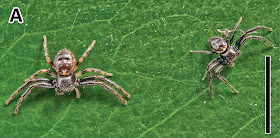Sociality is rare in Spiders, which are by nature solitary and aggressive. However it is known to have evolved separately several times in different Spider groups, and this occurrence is considered a good model for the understanding of the evolution of sociality across the animal kingdom, because it involves a switch in behaviour which is apparently strongly against the basic nature of Spiders. Social Spiders gain an advantage over non-social species in that they are able to hunt collectively, thereby often targeting larger prey, and mount a common defence against predators. However they also suffer disadvantages compared to other species, in the form of competition for resources within the nest.
In the case of Spiders competition for mates can be an important evolutionary driver, as male Spiders are typically only capable of mating with a single female, and the evolution of sociality often comes via the ‘subsocial route’, wherein species go through a subsocial stage, with Spiders living communally during a period of extended maternal care, but dispersing prior to mating, and the switch from subsociality to full sociality (in which Spiders live communally for their entire lives) being also accompanied by a switch from outbreeding (mating between unrelated Spiders) to inbreeding (mating between related Spiders, within the same nest), a switch that tends to trigger other evolutionary changes.
Sociality is known to have arisen separately in at least eight groups of Spiders. The majority of these are web-builders, with the advantages of larger, communally built webs, that are capable of netting larger prey, seems to be important in the development of sociality. However it is also found in two groups of non-web-building Spiders, Huntsman Spiders (Sparassidae) and Crab Spiders (Thomisidae). In both cases this development has been found only in Australia, a continent whose long isolation and harsh climate has led to novel innovations in a wide variety of organisms.
The social Huntsman Spiders were formerly placed in two genera, Delena and Eodelena, however a recent molecular study of the group has revealed that all are more closely related than previously thought, and all are now placed within the single genus Delena. Three species of social Crab Spiders described to date, all of which have been placed within the genus Diaea.
In a paper published in the journal ZooKeys on 21 July 2014, Jasmin Ruch of the Department of Biological Sciences at Macquarie University and the Zoological Institute and Zoological Museum at Biocenter Grindel at the University of Hamburg, Torben Riehl, also of the Zoological Institute and Zoological Museum at Biocenter Grindel and Peter Michalik of the Zoological Institute and Museum at Ernst-Moritz-Arndt-University, describe the occurrence of subsocial behaviour in a fourth species of Australian Crab Spider, Xysticus bimaculatus from southern Queensland. Xysticus bimaculatus was first described in 1867, but its behaviour has not been studied until now.
Male and female Xysticus bimaculatus. Scale bar is 1 cm. Ruch et al. (2014).
Ruch et al. found that Xysticus bimaculatus builds social nests containing multiple females and their young. The nests were built from leaves in broadleaved forests around Brisbane (all species of Diaea nest exclusively in Eucalyptus trees, and none occur as far north as Brisbane), with the most used tree being the Blackwood (Acacia melanoxylon), which is also the most abundant tree in the area, though the Spiders seemed quite willing to use any tree. The nests were constructed from leaves, with the spiders inhabiting old, brown leaves at the centre of the nest, but continuously adding new green leaves to the outside.
The Spiders attach leaves with silk to construct a typical nest. Scale bar is 1 cm. Ruch et al. (2014).
Most nests contained a single female and her young, however nests in which multiple adults were found caring for a single brood, and nests in which there was more than one separate brood were also found. The Spiders have an annual life-cycle, and all the young within a nest appeared to be the same age. The likelihood of the females being present with the young decreased as the Spiderlings grew, though whether this was due to matrophagy (the eating of the mother by the young, common in Spiders) or some other factor was unclear.
Prey items found within the nests included mainly Beetles and Ants, however Wasps, Caterpillars and Flies were apparently also consumed. Wooly Scale Insects and Cockroaches were found living in some nests as apparent commensals (species living in the nest of another without harming or benefiting the host), and other species of Spider (potential predators of young Spiderlings) were also found in some nests.
See also…
Cave Spiders (Nesticidae) are found across the Mediterranean Basin, as well as in the Canary Islands...
In 2011 Paul Seldon of the College of Life Sciences at Capital Normal University in Beijing, the Paleontological Institute and Department of Geology at the University of Kansas and the Natural History Museum in London, along with ChungKun Shih and Dong Ren, also of the College of Life Sciences at Capital Normal University, described a large female Spider...
Social Spiders are unusual in that the females form colonies of hundreds to thousands of individuals, which cooperate in the building of webs, capture of prey, defence of the colony and raising of young. Unlike...
Follow Sciency Thoughts on Facebook.





